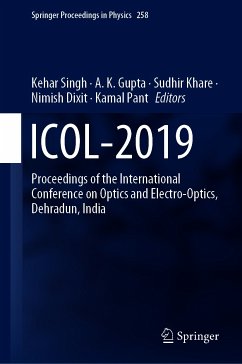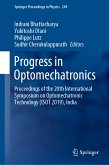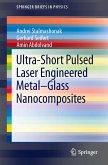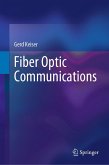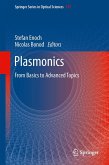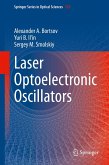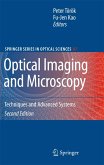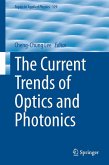ICOL-2019 (eBook, PDF)
Proceedings of the International Conference on Optics and Electro-Optics, Dehradun, India
Redaktion: Singh, Kehar; Pant, Kamal; Dixit, Nimish; Khare, Sudhir; Gupta, A K


Alle Infos zum eBook verschenken

ICOL-2019 (eBook, PDF)
Proceedings of the International Conference on Optics and Electro-Optics, Dehradun, India
Redaktion: Singh, Kehar; Pant, Kamal; Dixit, Nimish; Khare, Sudhir; Gupta, A K
- Format: PDF
- Merkliste
- Auf die Merkliste
- Bewerten Bewerten
- Teilen
- Produkt teilen
- Produkterinnerung
- Produkterinnerung

Hier können Sie sich einloggen

Bitte loggen Sie sich zunächst in Ihr Kundenkonto ein oder registrieren Sie sich bei bücher.de, um das eBook-Abo tolino select nutzen zu können.
This book presents peer-reviewed articles from the International Conference on Optics and Electro-optics, ICOL-2019, held at Dehradun in India. It brings together leading researchers and professionals in the field of optics/optical engineering/optical materials and provides a platform to present and establish collaborations in this important area, with the theme "Trends in Electro-optics Instrumentation for Strategic Applications". Topics covered but not limited to are Optical Engineering, Optical Thin Films, Optical Materials, IR Sensors, Image Processing & Systems, Photonic Band Gap…mehr
- Geräte: PC
- ohne Kopierschutz
- eBook Hilfe
- Größe: 39.29MB
![Progress in Optomechatronics (eBook, PDF) Progress in Optomechatronics (eBook, PDF)]() Progress in Optomechatronics (eBook, PDF)81,95 €
Progress in Optomechatronics (eBook, PDF)81,95 €![Ultra-Short Pulsed Laser Engineered Metal-Glass Nanocomposites (eBook, PDF) Ultra-Short Pulsed Laser Engineered Metal-Glass Nanocomposites (eBook, PDF)]() Andrei StalmashonakUltra-Short Pulsed Laser Engineered Metal-Glass Nanocomposites (eBook, PDF)40,95 €
Andrei StalmashonakUltra-Short Pulsed Laser Engineered Metal-Glass Nanocomposites (eBook, PDF)40,95 €![Fiber Optic Communications (eBook, PDF) Fiber Optic Communications (eBook, PDF)]() Gerd KeiserFiber Optic Communications (eBook, PDF)48,95 €
Gerd KeiserFiber Optic Communications (eBook, PDF)48,95 €![Plasmonics (eBook, PDF) Plasmonics (eBook, PDF)]() Plasmonics (eBook, PDF)105,95 €
Plasmonics (eBook, PDF)105,95 €![Laser Optoelectronic Oscillators (eBook, PDF) Laser Optoelectronic Oscillators (eBook, PDF)]() Alexander A. BortsovLaser Optoelectronic Oscillators (eBook, PDF)121,95 €
Alexander A. BortsovLaser Optoelectronic Oscillators (eBook, PDF)121,95 €![Optical Imaging and Microscopy (eBook, PDF) Optical Imaging and Microscopy (eBook, PDF)]() Optical Imaging and Microscopy (eBook, PDF)217,95 €
Optical Imaging and Microscopy (eBook, PDF)217,95 €![The Current Trends of Optics and Photonics (eBook, PDF) The Current Trends of Optics and Photonics (eBook, PDF)]() The Current Trends of Optics and Photonics (eBook, PDF)73,95 €
The Current Trends of Optics and Photonics (eBook, PDF)73,95 €-
-
-
Dieser Download kann aus rechtlichen Gründen nur mit Rechnungsadresse in A, B, BG, CY, CZ, D, DK, EW, E, FIN, F, GR, HR, H, IRL, I, LT, L, LR, M, NL, PL, P, R, S, SLO, SK ausgeliefert werden.
- Produktdetails
- Verlag: Springer Nature Singapore
- Seitenzahl: 914
- Erscheinungstermin: 1. März 2021
- Englisch
- ISBN-13: 9789811592591
- Artikelnr.: 61263807
- Verlag: Springer Nature Singapore
- Seitenzahl: 914
- Erscheinungstermin: 1. März 2021
- Englisch
- ISBN-13: 9789811592591
- Artikelnr.: 61263807
- Herstellerkennzeichnung Die Herstellerinformationen sind derzeit nicht verfügbar.
